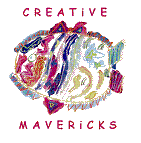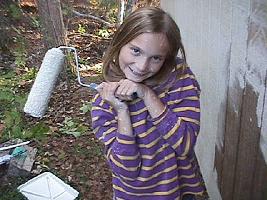
Highly Creative Learners
|
Creative children look twice |
Charles Schaefer in his book, Developing Creativity in Children: An Idea Book for Teachers (pages 88 - 90), discusses the following characteristics of creative children, some of which, he says, appear at the earliest years:
- Sense of wonder - heightened awareness of the world
- Openness to inner feelings and emotions
- Curious, exploratory, adventuresome spirit
- Imagination
- Imagination is the power of forming mental images of what is not actually present to the senses or of creating new images by combining previously unrelated ideas.
- Intuitive thinking
- Intuitive thinking is the solving of problems without logical reasoning. The intuitive thinker is open to hunches and is able to make good guesses.
- Independent thinker
- Personal involvement in work
- The creative person identifies with a task so that he becomes totally absorbed in and dominated by his work. He enthusiastically engages in tasks that are personally meaningful and satisfying.
- Divergent thinker
- As opposed to convergent thinking, which seeks the one right answer, as determined by the given facts, divergent thinking is defined as the kind that goes off in different directions...that seeks variety and originality, that proposes several possibilities rather than seeking one right answer.
- Predisposition to create
- Tendency to express things in an original, idiosyncratic way rather than considering how things are supposed to be or always have been expressed.
- Tendency to play with ideas
Many creative learning behaviors are indicative of right brained rather than left brained functioning. Barbara Meister (1982) in her book, Unicorns Are Real: A Right Brained Approach to Learning, describes the modes of consciousness of the right and left brain hemispheres. Some of her descriptors are:
Left Hemisphere |
Right Hemisphere |
| linear | holistic |
| logical | intuitive |
| verbal | nonverbal |
| temporal | nontemporal |
| abstract | analogic (a bent towards analogy) |
Howard Gardner (1983), in his book, Frames of Mind: The Theory of Multiple Intelligence, extensively describes seven intelligences, five of which are right-brain and not traditionally recognized in education. Gardner subsequently added two more right-brain intelligences. The two left-brain intelligences are:
The seven right-brain intelligences are:
|
 |
Examples of professions drawing upon these intelligences are:
- Linguistic: poet, writer, public speaker, lawyer
- Logical-mathematical: mathematicians, scientists
- Musical: composers, musicians
- Visual-Spatial: the arts, engineering
- Bodily-Kinesthetic: dancers, athletes, actors
- Interpersonal: political and religious leaders, teachers, therapists
- Intrapersonal: novelist, wise elder
- Naturalist Intelligence: biologists, artists, photographers
- Existential Intelligence: philosophers, theologians, novelists
References:
Gardner, H. 1983. Frames of Mind: The Theory of Multiple Intelligences. New York: Basic Books
Schaefer, C. E. 1973. Developing Creativity in Children. Buffalo, N.Y.: D.O.K. Publishers
Vitale, B.M. 1982. Unicorns Are Real: A Right Brained Approach to Learning . Rolling Hills Estates, CA: Jalmar Press
Most of our pages are available in a printer-friendly, text-only, pdf format, readable by Adobe Reader. Need Adobe Reader? You can download it for free at Adobe.com
